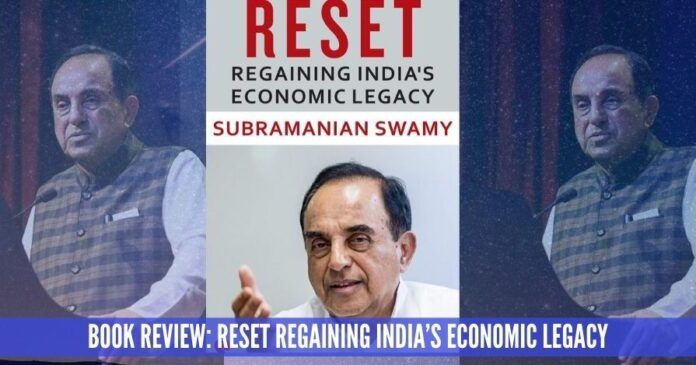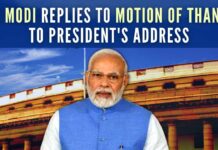
The following is a review of Dr. Subramanian Swamy’s book titled “RESET: Regaining India’s Economic Legacy” (Rupa Publication, 2019)
Morgan Stanley’s Ruchir Sharma once stated: “India disappoints both optimists and pessimists”. The travesty and the conundrum of the semi-comatose Indian economy leave contemporary policymakers in want of levers that exist, are effective, and (most importantly) are at their disposal.
Having accurately predicted the current slowdown in the Indian economy, many eagerly awaited Dr Subramanian Swamy’s book “RESET”. The adroit and vocal Bharatiya Janata Party (BJP) leader promised to produce a primer in economics, which he admits is his first love among academic disciplines.
While Dr Swamy applauds PM Modi’s “unstudied familiarity with microeconomics”, he recommends a more comprehensive approach to address the “complex multivariate general equilibrium” macroeconomic issues facing India today.
As a revised rendition of his 1970 monograph titled “Swadeshi Plan”, he highlights in the Preface his ultimate objective of developing an indigenous economic plan which is not tardily borrowed from outside, but one that is appreciative of the Indian ethos and practicalities:
- “I also felt there was a third way of economic development which would harmonize a number of objectives, such as growth, social justice and creating room for spiritual values. Both socialism and the market economy are purely materialist, and that suits the West, but it does not suit Indian culture, which venerates sacrifice and simple living”
While he lists a series of short and medium-term measures for the revival of the economy in the final chapter of RESET, the preceding chapters serve as a foundation of how and why he arrived at these policy prescriptions. At the very core, his approach is based on the abstract idea:
- “Search for incentives to cajole the stakeholders in the economy to get enthusiastic about economic activity and be incentivized for it”
For a country perennially marred with non-compliance and economic offences at various levels, a question has remained unanswered for all governments since independence – is it coercion or persuasion that is more effective to increase compliance in India? Dr Swamy’s response:
- “With their long commercial history and culture, Indians cannot be inspired or deterred by suffocating regulations. If the government-imposed controls and regulations go against the individual’s incentive and good sense, the average Indian will subvert it and render ineffective these restrictions”
Through a series of examples, Dr Swamy demonstrates how the policymakers invariably and erroneously placed faith in the high-handed state and the central planning commissions. He believes that both under British-raj (pre-1947) and under the influence of the Soviet Union (post-1947) the individualistic and entrepreneurial Indian has been shackled and deprived of opportunities to realize his full potential. He asserts that even today the structure of the Indian polity is reminiscent of the Soviet model:
- “Between 1992 and 1996, the Government of Narasimha Rao as the prime minister deregulated the economy across the board but without making structural changes. Even today, economic policy is dominated by the thinking in the government that economic regulations can be liberalized, reduced and simplified but not necessarily abolished. That, unfortunately, is the unwavering mindset in India”
- “All the Five-Year Plans that have been formulated from 1951 have incorporated varying objectives and priorities. But the strategy underlying the attainment of the objectives has been remarkably the same: strengthening the public sector”
As an alternative, he enunciates what the role of the government should indeed be in the Indian context. Later in the appendix, he provides a detailed comparison across capitalism, communism, socialism, and Pandit Deendayal Upadhyay’s Integral Humanism. According to him:
- “The correct economic policy is one that is largely based on the use of the market mechanism, with the government as an umpire in the clash of demand and supply forces and as an enlightened patron, guiding market forces to equilibrium by incentive whenever distortions take place. Such an incentive-based market system is also in consonance with the Indian cultural values of individualism and collective harmony”
Across chapters, Dr Swamy draws parallels between China, Europe, East Asia, United States, Independent India, India under British-raj, and India under the Princely States. He describes how agriculture, railways, and other industries evolved and how labour, capital, and other resources were mobilized over the last few centuries. Taking cognizance of these indigenous historical accounts he propounds:
- “The growth potential of the economy over a medium period depends upon a number of factors. First, the capacity of the economy to maintain a sufficiently high rate of investments and domestic savings. Second, ensuring productive use of that capital investment. Third, the deployment of innovation”
In conclusion, while RESET is a fairly technical and data-heavy primer, it is a fast-paced and carefully compartmentalized economic journey of India, the next chapter of which is currently being penned by Prime Minister Narendra Modi and his cabinet. While Dr Swamy applauds PM Modi’s “unstudied familiarity with microeconomics”, he recommends a more comprehensive approach to address the “complex multivariate general equilibrium” macroeconomic issues facing India today.
Note:
1. The views expressed here are those of the author and do not necessarily represent or reflect the views of PGurus.
- Dispelling four deleterious assumptions: India-China - October 29, 2020
- Dr. Swamy’s 2002 prediction has come true - October 8, 2020
- Book Review – “RESET: Regaining India’s Economic Legacy” - December 30, 2019










